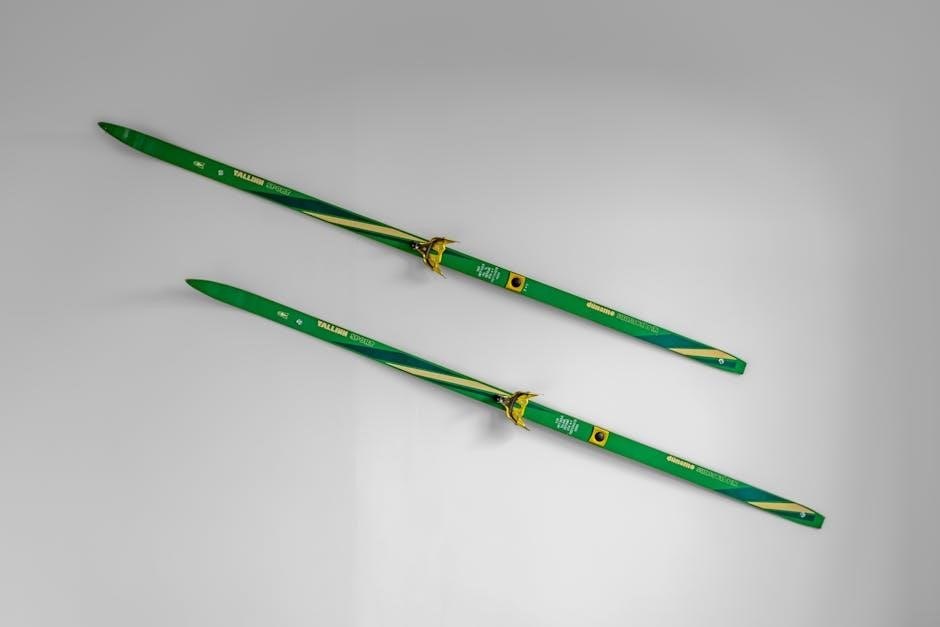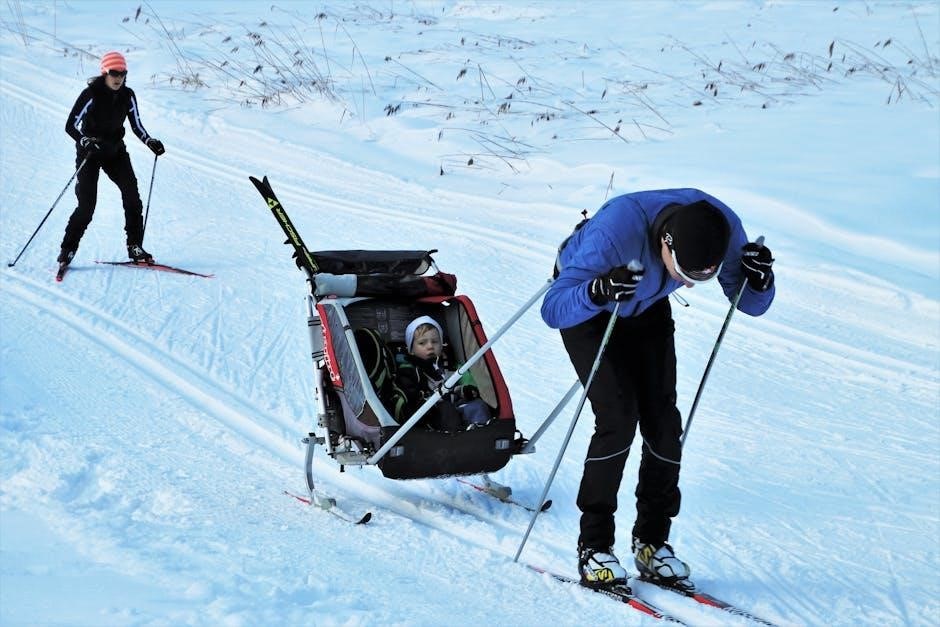cross country ski size guide

Embarking on cross-country skiing requires understanding proper ski sizing. This guide provides comprehensive information for selecting the right ski size‚ ensuring optimal performance and enjoyment on the trails.
Cross-country ski sizing differs significantly from alpine skiing‚ primarily relying on the skier’s weight rather than height. Whether you’re into skate skiing‚ classic cross-country‚ or Nordic touring‚ manufacturers provide size charts based on weight. Correct sizing is crucial for performance.
Selecting the right cross-country ski size is essential for an enjoyable experience. Much like selecting the correct shirt size‚ this process determines comfort. Proper ski length enhances control and maneuverability. A well-chosen size optimizes your time on the snow.

Understanding the Importance of Proper Ski Size
Proper ski size is critical for control‚ stability‚ and maneuverability on the trails. Correct sizing minimizes injury risk and ensures an enjoyable and efficient cross-country skiing experience.
Enhanced Control‚ Stability‚ and Maneuverability
Selecting the correct ski size significantly enhances control‚ stability‚ and maneuverability‚ directly impacting the skier’s ability to navigate various terrains and execute techniques effectively. Properly sized skis provide a balanced feel‚ allowing for precise movements and improved responsiveness. This translates to greater confidence on the snow‚ enabling skiers to tackle challenging conditions with ease. Skis that are too long can feel cumbersome and difficult to control‚ while skis that are too short may lack stability and compromise maneuverability. Ultimately‚ the right ski size empowers skiers to optimize their performance and fully enjoy the cross-country experience.
Minimizing Risk of Injuries
Choosing the correct cross-country ski size is crucial for minimizing the risk of injuries. Ill-fitting skis can compromise balance and control‚ increasing the likelihood of falls and strains. Skis that are too long may be difficult to maneuver‚ leading to awkward movements and potential joint stress. Conversely‚ skis that are too short may not provide adequate support‚ increasing the risk of ankle or knee injuries. Proper ski sizing ensures a stable and balanced platform‚ allowing for efficient movement and reducing the strain on muscles and joints. Prioritizing the correct ski size contributes significantly to a safer and more enjoyable cross-country skiing experience.

Factors Influencing Cross Country Ski Size
Several factors influence the appropriate cross-country ski size. These include skier weight‚ height‚ and skiing style. Understanding these elements ensures a proper fit for optimal performance and safety.
Skier’s Weight as Primary Determinant
In cross-country skiing‚ a skier’s weight is the primary factor determining ski size. Unlike alpine skiing‚ where height plays a significant role‚ cross-country ski sizing relies heavily on weight to ensure proper ski flex and performance. Ski manufacturers provide size charts based on weight ranges to guide skiers in selecting the appropriate ski length. These charts help match the ski’s stiffness to the skier’s mass‚ optimizing glide‚ grip‚ and control. Choosing a ski that aligns with your weight is essential for an efficient and enjoyable skiing experience.
Consideration of Skier’s Height
While weight is the primary determinant‚ a skier’s height also plays a secondary role in selecting the ideal cross-country ski size. After determining the appropriate ski length based on weight‚ height can be used as a tiebreaker when between sizes. Taller skiers within a weight range may benefit from slightly longer skis for enhanced stability and glide. Conversely‚ shorter skiers may prefer shorter skis for improved maneuverability and control. Some charts suggest multiplying height by a factor to approximate ski length‚ providing a starting point for consideration alongside weight.
Skiing Style: Classic vs. Skate vs. Backcountry
The intended skiing style significantly influences ski size selection. Classic skiing utilizes longer skis for efficient gliding and striding within groomed tracks. Skate skiing requires shorter‚ stiffer skis for the side-to-side propulsion technique. Backcountry skiing demands wider‚ more robust skis for stability and control in ungroomed terrain and varying snow conditions. Classic skis often feature waxable or waxless bases‚ while skate skis prioritize stiffness for power transfer. Backcountry skis may incorporate metal edges for enhanced grip and durability. Selecting the appropriate ski size and type based on skiing style is crucial for optimal performance and enjoyment.
Cross Country Ski Sizing Charts and Recommendations
Utilize sizing charts tailored to classic and skate skiing. These charts provide recommendations based on weight‚ helping determine the appropriate ski length for optimal performance and control.
Weight-Based Size Charts for Classic Skiing
Classic cross-country ski sizing heavily relies on the skier’s weight. These charts provide a range of recommended ski lengths (in centimeters) based on the skier’s weight (in pounds). Remember that longer skis generally offer more glide and speed‚ while shorter skis provide enhanced maneuverability and control‚ especially for beginners. When consulting a classic ski sizing chart‚ identify the weight range that corresponds to your weight. The chart will suggest a ski length range. Factors such as skill level and terrain can influence the final ski length selection.
Weight-Based Size Charts for Skate Skiing
Similar to classic skiing‚ skate ski size charts primarily use weight as the determining factor. However‚ skate skis are generally shorter than classic skis. The chart will provide a range of ski lengths based on your weight. These charts are designed to provide a starting point for determining the right size. As with classic skis‚ consider your skill level and the type of terrain you’ll be skiing on. The skate ski size chart will help you choose the best ski length to maximize your performance.
Adjustments Based on Skill Level and Intended Use
While weight-based charts offer a baseline‚ consider your skill level and intended use. Beginners might prefer slightly shorter skis for increased control‚ while experienced skiers may opt for longer skis for enhanced speed. For recreational skiing on groomed trails‚ stick closer to the chart recommendations. If you plan on venturing off-trail or into backcountry terrain‚ a slightly wider and longer ski might provide better stability and flotation in deeper snow conditions. Skill level and intended use should always factor into your choice.

Types of Cross Country Skis and Sizing Considerations
Cross-country skis come in classic‚ skate‚ touring‚ and backcountry styles‚ each with unique sizing considerations based on length‚ stiffness‚ and intended use across varying terrains.
Classic Skis: Length and Stiffness
Classic skis‚ designed for traditional cross-country skiing within groomed tracks‚ require careful consideration of length and stiffness. Generally‚ classic skis are longer than skate skis‚ aiding the stride and glide motion. The appropriate length is primarily determined by the skier’s weight‚ influencing the ski’s interaction with the snow.
Stiffness plays a vital role; a stiffer ski is suitable for heavier skiers‚ ensuring effective kick and glide. Softer skis are better for lighter individuals‚ allowing proper compression for grip. Selecting the right balance optimizes performance and control during classic cross-country skiing.
Skate Skis: Shorter Length‚ Stiffer Camber
Skate skis‚ engineered for the skating technique in cross-country skiing‚ feature a shorter length and stiffer camber compared to classic skis. The shorter length enhances maneuverability and quick edge changes‚ crucial for the skating motion. A stiffer camber ensures efficient energy transfer during the push-off phase‚ maximizing speed and glide.
The skier’s weight is paramount in determining the appropriate skate ski size and stiffness. A stiffer ski supports the skier’s weight during the skating motion‚ while the shorter length facilitates agility and control on the track.
Touring Skis: Length and Width
Touring skis‚ designed for exploring varied terrains‚ require careful consideration of both length and width. Length typically falls between classic and backcountry skis‚ offering a balance of glide and control. Wider skis provide increased stability and floatation in softer snow conditions‚ enhancing off-track performance.
The appropriate length depends on skier height and weight‚ while width selection hinges on intended use and snow conditions. Wider touring skis are advantageous for backcountry excursions‚ while narrower options excel on groomed trails. Finding the right balance ensures an enjoyable touring experience.
Backcountry Skis: Stability and Robustness
Backcountry skis are engineered for off-trail exploration‚ emphasizing stability and robustness to handle diverse and challenging terrains. Length is crucial‚ generally shorter than classic skis for maneuverability‚ but longer for floatation in deep snow. Width plays a vital role‚ with wider skis providing increased stability and buoyancy in ungroomed conditions.
Construction materials are selected for durability‚ ensuring the skis can withstand the rigors of backcountry use. Reinforced edges and robust cores enhance resistance to impacts and abrasion; Consider terrain and snow conditions when selecting backcountry skis.
Additional Tips for Selecting Ski Size
For optimal ski selection‚ consider consulting experienced ski fitters. Their expertise ensures the chosen size aligns with individual needs‚ enhancing the overall cross-country skiing experience.
Consulting with Ski Fitters
Seeking advice from ski fitters offers invaluable personalized guidance‚ as they possess extensive knowledge of ski sizing nuances. Fitters consider individual weight‚ height‚ and skiing style to recommend the most appropriate ski length and stiffness. Their expertise ensures optimal performance‚ control‚ and comfort on the trails. Furthermore‚ fitters can assess individual biomechanics‚ identifying potential issues that may affect ski selection. They also account for skiing location and snow conditions‚ tailoring recommendations to specific environments. Consulting a fitter minimizes the risk of selecting an ill-fitting ski‚ preventing potential injuries and maximizing enjoyment.
Considering Skiing Location and Snow Conditions
Skiing location and snow conditions significantly impact ski selection. Groomed trails favor narrower‚ longer skis for efficient glide‚ while off-trail adventures demand wider‚ shorter skis for stability. Icy conditions necessitate skis with enhanced grip‚ while deep powder requires skis with ample surface area for flotation. Understanding local terrain and typical snow conditions is essential for choosing the right ski. Moreover‚ consider the frequency of groomed trails versus ungroomed terrain. Selecting skis that align with the predominant conditions ensures optimal performance and enjoyment. It is prudent to assess location-specific factors before making a purchase.
Cross Country Ski Boot Sizing Chart
Selecting the correct cross-country ski boot size is paramount for comfort and performance. A properly sized boot ensures a snug fit‚ preventing slippage and blisters. Utilize a comprehensive sizing chart that correlates foot length with corresponding boot sizes in various systems (US‚ EU‚ UK). Measure your foot length accurately while wearing ski socks. Consult brand-specific sizing charts‚ as variations exist. Consider foot width; some brands offer wider models. Ensure adequate toe room while maintaining a secure heel hold. Ill-fitting boots can lead to discomfort‚ reduced control‚ and potential injuries. Prioritize accurate measurements and brand-specific charts for optimal boot fit.

Cross Country Ski Pole Sizing Chart
Accurate cross-country ski pole sizing is crucial for efficient propulsion and balance. A sizing chart typically correlates skier height with recommended pole length. For classic skiing‚ poles should reach approximately to the armpit. For skate skiing‚ poles should extend to the shoulder or slightly higher. Adjustments may be necessary based on individual preferences and terrain. Shorter poles are often preferred for uphill climbs‚ while longer poles provide greater power on flat terrain. Using poles of the wrong length can lead to inefficient technique‚ fatigue‚ and potential injuries. Consult a reliable sizing chart and consider personal preferences for optimal pole selection.